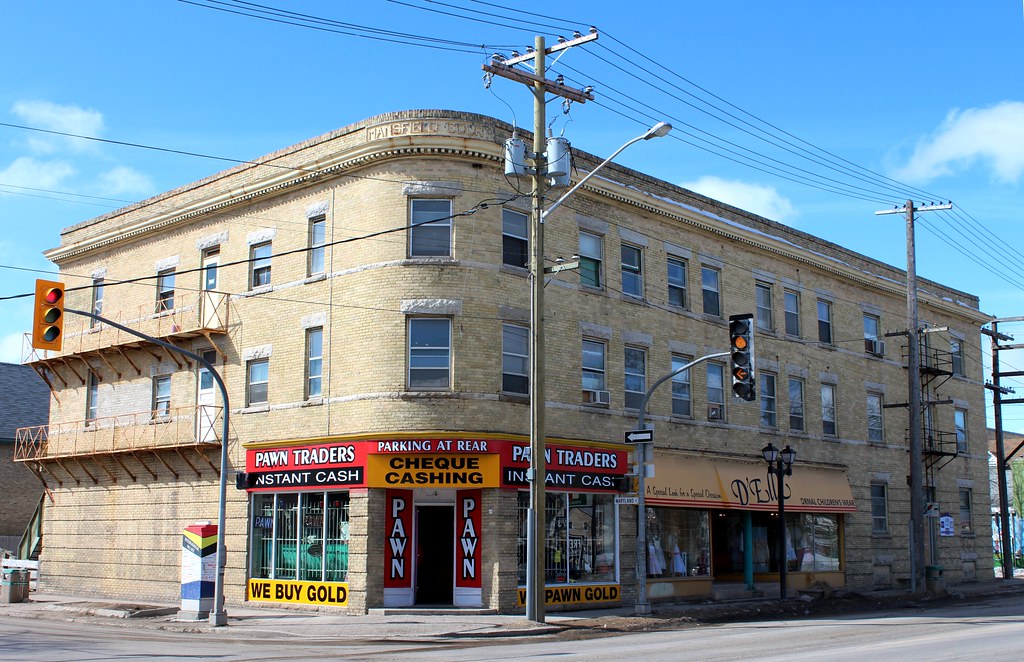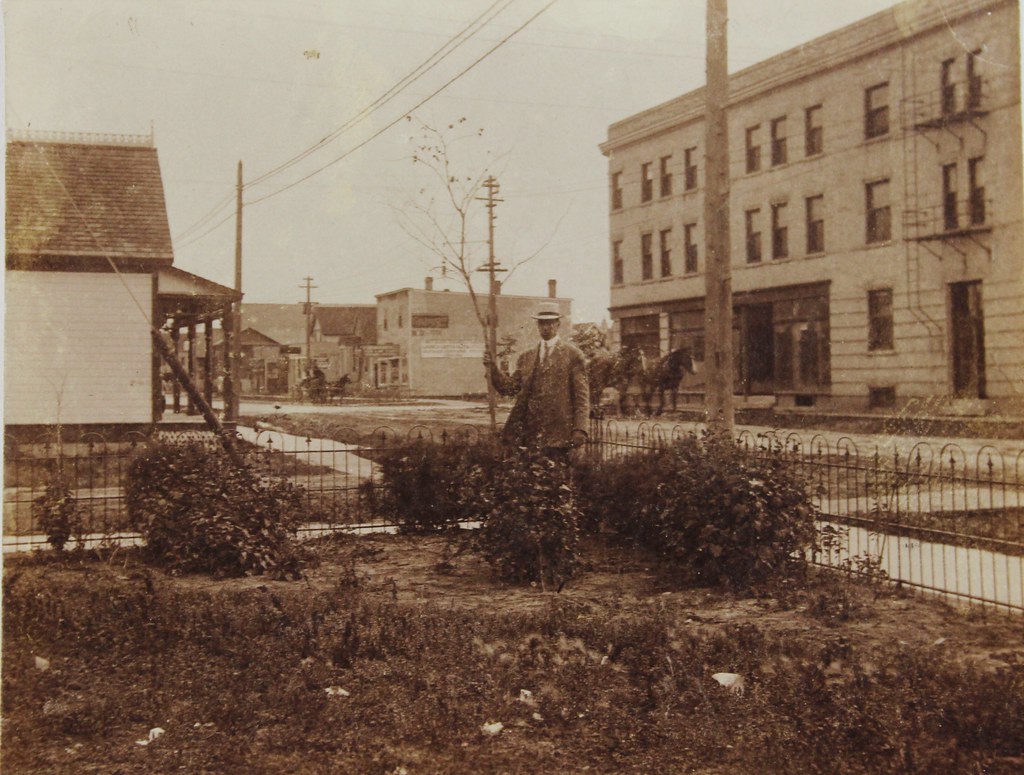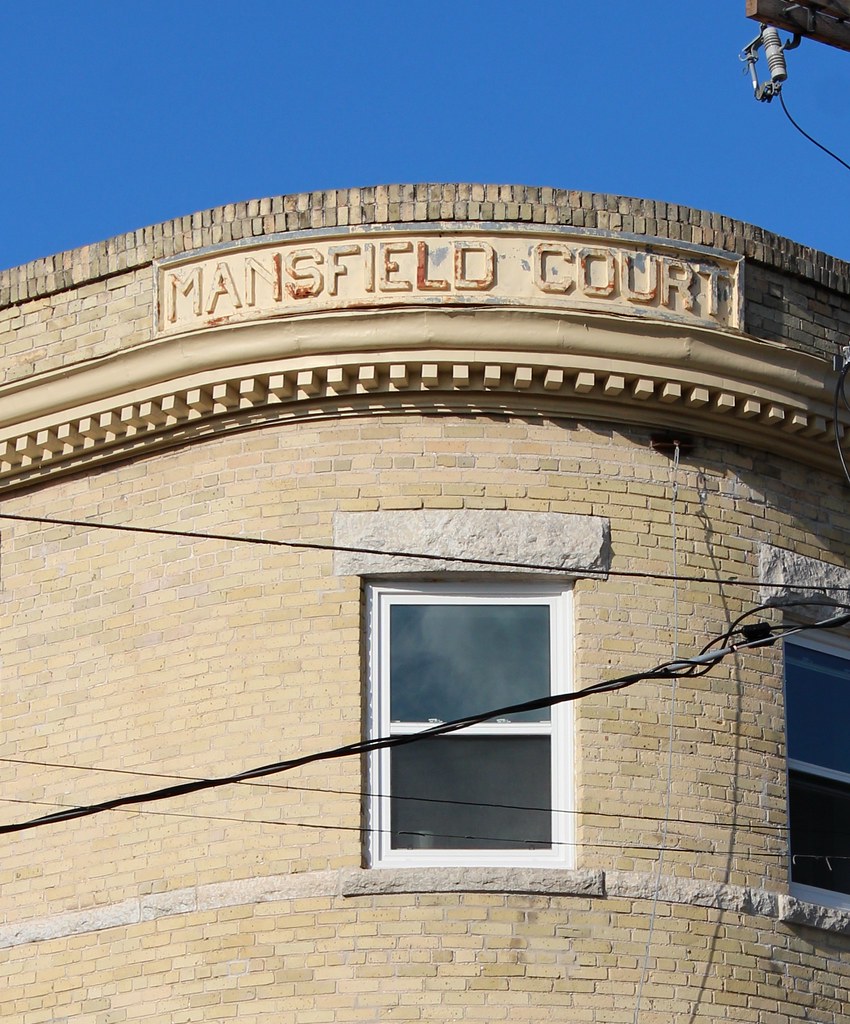Place: Mansfield Court
Address: 626 Ellice Avenue (at Maryland)
Built: 1908
Architect: James A. Gauld
Contractor: Alfred Miller and Co.
Mansfield Court was constructed in 1908, not long after city water and sewer was run in the area. This makes it one of the community's earliest remaining landmarks along with the first St. Matthews Church (now West End Cultural Centre) and First English Lutheran Church (now City Church).
Landowner Levi Lewis turned to architect James A. Gauld to design the $80,000 building. Gauld had recently come to Winnipeg from London, Ontario where he was known for his work designing large houses. He was only in Winnipeg for a brief time and designed a couple of apartment blocks. This is the only one that remains.
Construction began in late 1908 and the exterior was completed by the end of February 1909. It was expected to open on April 1, 1909. Lewis, who was primarily a developer, sold the building before it opened to the Hackett Investment Company. They, in turn, sold it to Jasper Halpenny in late April 1909.
Halpenny was an odd combination of professor, land developer, businessman, and respected surgeon. Five years after purchasing Mansfield Court he was elected president of the Manitoba Medical Association.
Mansfield Court's residential portion, the entrance off of Ellice Avenue, originally housed 30 residential units ranging from two to four bedrooms. Features included in-wall beds and gas ovens. The main floor consisted of three retail units.
Residential Section
The first wave of tenants is what you would expect from a middle-class block in a new suburb. There was a driver for a dairy, manager of a loan company, a few salesmen, a clerk at the CPR ticket office, three Eaton’s employees, and a butcher. The first caretaker, Charles Thrower, lived in suite one. Due to its proximity to John M. King School, many of the residences included young families.
Around ten men associated with Mansfield Court served in the First World War.
Scottish-born Sergeant John. R. Dymond was a boilermaker by trade when he enlisted in 1914. He went to England in 1915 and France in January 1916. In December 1918, he was awarded the Military Medal for bravery in the field.
During the war, Lily, lived at suite 8, Mansfield Court. She and John married in 1914 just before he left.
Dymond returned in 1919 and the couple moved to a house. He was an engineer at the Fort Osborne Barracks powerhouse for over 25 years.
Oscar Thorsteinsen also received the Military Medal for Valour. He was living in Keeewatin, Ontario and moved to Winnipeg, suite 2 of Mansfield Court, in 1916 before enlisting later that year.
Bertram Hanson, whose wife moved to suite 24 when he went overseas, served near the front lines with a medical corps and suffered shrapnel wounds when he was recusing a soldier from "no man's land".
During his recovery, he fell seriously ill from malaria. It appears Hanson survived both his wounds and the disease.
It appears that just one man, 25-year-old Alexander Cooper, was killed.
Originally from Aberdeen, Scotland, the street car conductor lived at 752 Home Street with wife, Bertha, when he enlisted on April 17, 1916. Like many couples, they had downsized during the war and Bertha moved to suite 12 at Mansfield Court.
That is where she lived when she received news that her husband was killed in action on July 25, 1917 serving with the 8th Battalion.
During World War II, around a half dozen people from Mansfield Court served.
One was Corporal Jean W. Inglis who lived with her parents in suite 20. She enlisted with Royal Canadian Air Force - WD (Women's Division) and attended the unit’s first training class at Camp Borden. Around 17,000 women served with the RCAF in the Second World War - about 8 per cent of its total wartime personnel.
Inglis was one of about 1,450 women posted overseas to serve at RCAF headquarters in London. She returned home in 1946 but died at the family home in 1949 of undisclosed caues. She was 30 years old.
July 28, 1951, Winnipeg Free Press
Some of the other thousands of people who called Mansfield Court home over the decades include the Knights, above, a retired couple from Carman, Manitoba.
The fate of middle-class apartment blocks began to change in the mid-1950s as the young couples and families that once filled them moved to newly created suburbs. Rents dropped and many who would have lived in boarding and rooming houses moved it. Less income meant less spent to maintain the buildings.
April 6, 1977, Winnipeg Free Press
In March 1977, the city of Winnipeg released its list of the 19 "worst" apartment blocks in the city in terms of living conditions - something prompted by the Town and Country Apartments fire on Preston Avenue that killed eight and injured seventeen a few weeks earlier. Mansfield Court was on the list.
A month later, the city closed the block down after declaring it unfit for human habitation.They cited a long-standing list of repairs ordered by the city that the owners had ignored.
Unlike some of the other buildings on the list, residents of Mansfield Court rallied in defense of the building. Some told the daily papers that many of the repairs were cosmetic in nature and that they didn't feel that their health and safety was at risk. (Only 22 of the building's 30 suites were in use tat the time due to unspecified damage to the ones along the east side of the building.)
Many were attracted to the block for its cheap rents. A one bedroom that cost $75 or $80 per month at the Mansfield would cost up to $200 in other blocks in the neighbourhood.
The residents got a reprieve until a new owner, A. Simoes Construction Ltd., was found and the repairs were done.
More recent news stories involving Mansfield Court include a 2016 murder and a fire in January 2019.
Commercial Section
While the residential section had no issues filling its suites, the retail section appeared to struggle for the first couple of years. It took until late 1911 for the three spaces to fill at once with a grocery store (at number 620), Modern Meat Market (622) and City Tea and Coffee Company (624).
The most prominent unit, number 620 at the intersection, was a grocers until at least into the 1970s. Names included Clements and MacDonald (1909), George Nicholson (1910 -14), Kell's Grocery 1915, and William Stanley's Grocery (1916 - 1933), Gibson Brothers in the early 1950s, Stones' Grocery through the 1960s, and Leslie's in the 1970s. In the 1980s it became Costas Trading Pawn Shop and remains a pawn shop to this day.
Number 622 was first home to Modern Meat Market from 1910 to 1915, Herbert Stoney's Upholstery and Furniture Repairs from 1920 - 22, then the William G Ashdown* Hardware Company and from 1924 to ca. 10953, Decorators Supply Ltd. run by Mrs. H. M. Weeden. It then became Modern Aupholstery for at least the next decade.
* One would think that Ashdown would be of the James H. Ashdown family but this is unclear. He did have a brother, William "S" - not G. I cannot find an obituary for this William to see if there was a family connection.
Number 624 was home to the wholesaler City Coffee and Tea Company from about 1910 to 1917, then the Workingman's Meat Market from about 1919 through the 1920s. In the 1930s it was an upholstery shop and clothing store, then circa 1937 became Ellice Billiards which lasted for at least the next 30 years.
In 1978 D'Ella's Formalwear opened in units 624 - 626. Its lease wasn't renewed in 2013 and some of that retail space was converted into additional suites which brought the number up to 39.











Who owns it now
ReplyDelete